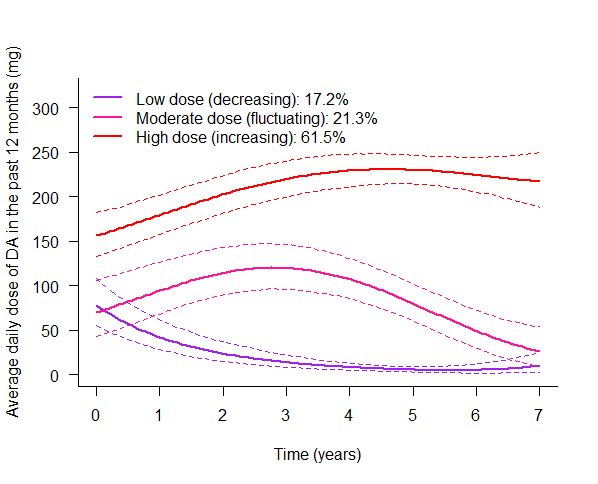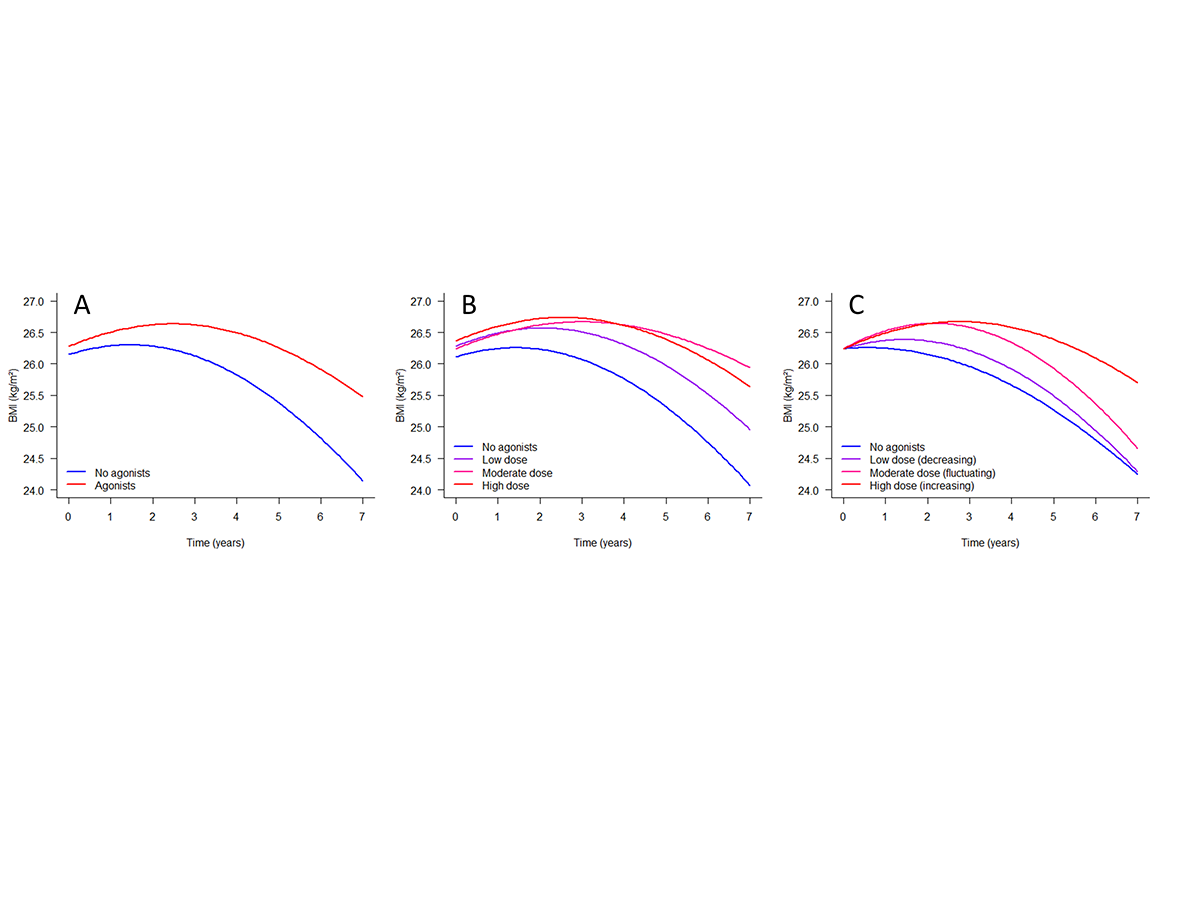Session Information
Date: Wednesday, September 25, 2019
Session Title: Epidemiology
Session Time: 1:15pm-2:45pm
Location: Les Muses, Level 3
Objective: To describe the longitudinal relation between dopaminergic agonists (DA) use and change of BMI in a longitudinal cohort of PD patients followed annually up to 6y.
Background: Although PD progression is generally accompanied by weight loss [1], little is known about predictors of weight change. DA represent the main risk factor of impulse control disorders (ICD) [2], including pathologic eating behavior which can lead to gain weight.
Method: We used data from a longitudinal cohort of PD patients with less than 5y disease duration at baseline followed annually up to 6y (DIG-PD). BMI (measured weight/height², kg/m²) was computed at each visit. Detailed drug data since disease onset was obtained. At each visit, symptoms of dopaminergic dysregulation, including pathologic eating behavior, were evaluated by movement disorders specialists (face-to-face semistructured interviews). Trajectories of DA dose were estimated using latent class mixed models. The association of DA use with change in BMI and weight gain was examined using a latent-process mixed models and time-dependent Cox models respectively.
Results: Among 356 patients (40.2% women; mean age=62.0y), 86.8% took DA at least once since disease onset and during the follow-up. Three trajectories of DA dose were identified: low (17.2%), moderate (21.3%), high (61.5%). [figure1] There was no difference in baseline BMI between DA users and non-users (P=0.48), but BMI decreased more slowly over the follow-up among DA users than non-users (P=0.005), with a dose-response relation between DA dose and BMI change (P=0.02). In addition, patients in the high DA dose trajectory group lost less weight than patients who never used DA (P=0.02). [figure2] When the models were adjusted for pathologic eating behavior, estimates decreased but remained significant. Over 6y, 125 patients gained ≥4kg. Incidence of weight gain was 84% higher in DA users compared to non-users (hazard ratio=1.84, 95% confidence interval=1.11, 3.04).
Conclusion: Weight loss is associated with PD progression. However, DA use was associated with less pronounced weight loss and even led to some patients gaining weight. Weight gain can lead to metabolic disorders and is an important cause of disability and worse physical performance. These findings warrant screening for eating disorders and monitoring weight in PD patients who use DA.
References: 1. Wills AM, Perez A, Wang J, Su X, Morgan J, Rajan SS, et al. Association Between Change in Body Mass Index, Unified Parkinson’s Disease Rating Scale Scores, and Survival Among Persons With Parkinson Disease: Secondary Analysis of Longitudinal Data From NINDS Exploratory Trials in Parkinson Disease Long-term Study 1. JAMA Neurol. 2016;73(3):321-8. 2. Corvol JC, Artaud F, Cormier-Dequaire F, Rascol O, Durif F, Derkinderen P, et al. Longitudinal analysis of impulse control disorders in Parkinson disease. Neurology. 2018;91(3):e189-e201.
To cite this abstract in AMA style:
F. Artaud, PC. Lee, M. Vidailhet, JC. Corvol, A. Elbaz. Longitudinal analysis of the relation between trajectories of dopaminergic agonists use and BMI in Parkinson’s disease [abstract]. Mov Disord. 2019; 34 (suppl 2). https://www.mdsabstracts.org/abstract/longitudinal-analysis-of-the-relation-between-trajectories-of-dopaminergic-agonists-use-and-bmi-in-parkinsons-disease/. Accessed December 19, 2025.« Back to 2019 International Congress
MDS Abstracts - https://www.mdsabstracts.org/abstract/longitudinal-analysis-of-the-relation-between-trajectories-of-dopaminergic-agonists-use-and-bmi-in-parkinsons-disease/


